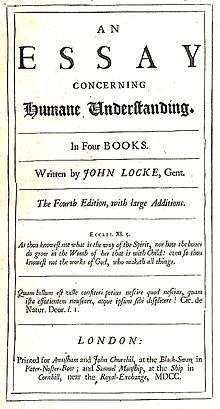Samuel Manship
Samuel Manship was an English stationer and bookseller in the City of London who acted as publisher for several noted writers and became a landowner in Surrey.
Samuel Manship | |
|---|---|
 | |
| Born | about 1665 |
| Died | January 1720 |
| Nationality | English |
| Occupation | Stationer, bookseller, publisher |
| Known for | Publication of philosophy and theology |
Life
Born about 1665, he was the second son of the Reverend John Manship (1612–1689) from Locking, Somerset and his wife Barbara. His father had been rector of the Anglican church of St Nicolas, Guildford but in 1662 was ejected and instead became a physician and Presbyterian preacher in Guildford.[1] His elder brother John Manship (1659–1705) became an Oxford don and physician.[2]
Samuel went into business in the City of London, being admitted a Citizen and Member of the Stationers Company. From premises in Cornhill, first at the sign of The Black Bull and later at The Ship, he sold books and stationery. His shop also served as a distribution point for many art sale catalogues[3]
His main fame is as a publisher who acted for a large number of contemporary writers, both English and French, on a variety of subjects, particularly philosophy and theology. Among his authors were :
Antoine Arnauld
Mary Astell
William Beveridge
Antoinette Bourignon de la Porte
François de Chavigny de la Bretonnière
Edmund Chishull
Henry Dodwell
Sir George Etherege
Sir Roger L'Estrange
John Locke
Nicolas Malebranche
Luke Milbourne
Pierre Nicole
John Norris
Christopher Packe
John Pennyman, the husband of Mary Pennyman[4]
John Rawlet
John Scott[5]
Susanna Wesley and
William Winstanley.[6][7]
In 1709 he acquired the manor and mansion of Field Place at Compton outside Guildford[8](the house sold for 6 million pounds in 2006).[9] As an elector in the Cornhill Ward, local activists of the Whig party wanted his vote and in a meeting on 16 December 1714 resolved to approach him through the Lord Chancellor, William Cowper, 1st Earl Cowper.[10] He was buried on 24 January 1720 in the new vault of the church of St Michael, Cornhill[11] and his will was proved on 1 February 1720[12]
Family
On 16 July 1692 he married Anne Lane[13] and they had seven children. His elder son John Manship (1695–1749), who went into business as a cloth merchant, in 1723 married Elizabeth Garbrand (1706–1788), a descendant of the bookseller Gerbrand Harkes, and inherited the estate at Compton on the death of his mother in 1734. The eldest surviving daughter Elizabeth Manship (1701–1733) married Richard Dowdeswell (1692–1730), a cousin of the landowner and politician William Dowdeswell.[14]
References
- Gordon, Alexander ed 1917 "Freedom after ejection; a review (1690–1692) of Presbyterian and Congregational nonconformity in England and Wales" at https://archive.org/ retrieved 13 October 2015
- Venn. Alumni Oxonienses; the Members of the University of Oxford, 1500–1714; Their Parentage, Birthplace, and Year of Birth, With a Record of Their Degrees at http://www.mocavo.com/ retrieved 25 October 2015
- The book shop of Samuel Manship at the Black Bull, Cornhill; in " The art world in Britain 1660 to 1735 " at http://artworld.york.ac.uk. Retrieved 12 October 2015
- https://openlibrary.org. Retrieved 13 October 2015
- Scott, John " ..Christian life : wheren is shew'd, I. The worth and excellency of the soul. II. The divinity and incarnation of our Saviour III. The authority of the Holy Scripture. IV. A dissuasive from apostacy. Vol. V. and last" White, Robert, 1645–1703, engraver; Zouch, Humphrey, printed for S. Manship and R. Wilkin, and are to be sold by W. Davis at the Black Bull in Cornhill, and J. Bonwick at the Hat and Star in St. Paul's Church-yard 1700 Early English Books II (Wing, STC II), 1641–1700 http://babordplus.univ-bordeaux.fr. Retrieved 13 October 2015
- British Library Catalogue http://explore.bl.uk/ retrieved 12 October 2015
- http://shakeosphere.lib.uiowa.edu. Retrieved 13 October 2015
- 'Parishes: Compton', in A History of the County of Surrey: Volume 3, ed. H E Malden (London, 1911), pp. 16–24 http://www.british-history.ac.uk/vch/surrey/vol3/pp16-24. Retrieved 7 October 2015
- http://www.countrylife.co.uk/property/2006s-big-country-house-sales-35773. Retrieved 12 October 2015
- 'Minutes of a Whig Club: 1714', in London Politics 1713–1717, London Pollbooks 1713, ed. H Horwitz, W A Speck and W A Gray (London, 1981), pp. 11–15 http://www.british-history.ac.uk/london-record-soc/vol17/pp11-15. Retrieved 12 October 2015
- Joseph Lemuel Chester ed, London 1882, The Parish Registers of Saint Michael Cornhill, London at https://archive.org/ retrieved 24 October 2015
- PROB 11/572/268 Will of Samuel Manship, Stationer of Compton Field Place, Surrey 1 February 1720 http://discovery.nationalarchives.gov.uk/ retrieved 12 October 2015
- London Metropolitan Archives, St Alban Wood Street, Register of baptisms 1662/3 – 1786, marriages 1662/3 – 1754, burials 1662/3 – 1786, P69/ALB/A/001/MS06527
- "24 Dec Richard Dowdeswell, of St Bartholomew nr the Royall Exchange,London, & Elizabeth Manship, of St Michael, Cornhill, London " Joseph Lemuel Chester ed, London 1882, The Parish Registers of Saint Michael Cornhill, London at https://archive.org/ retrieved 24 October 2015